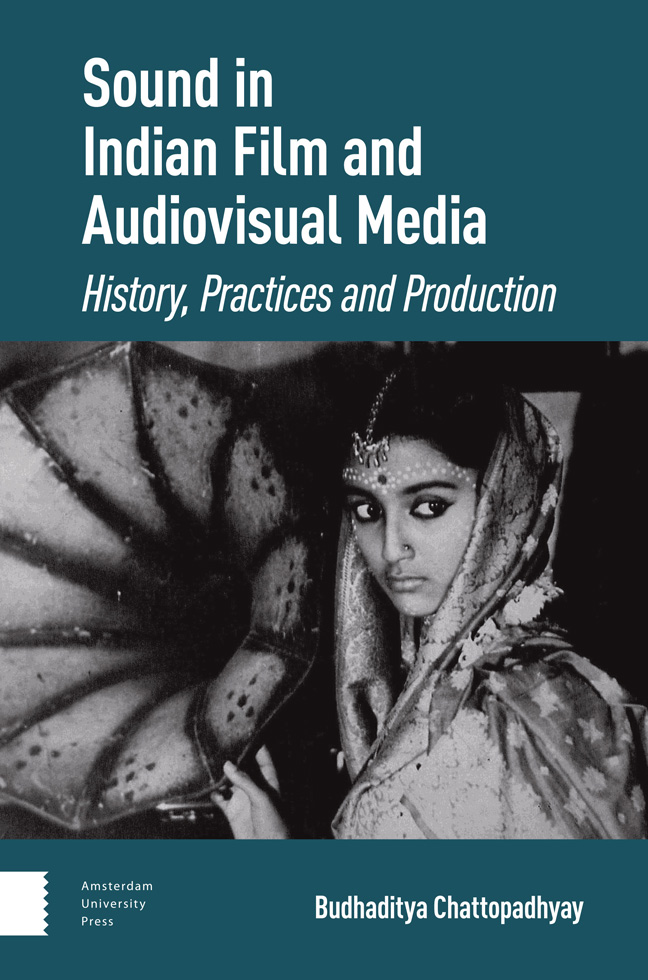Book contents
- Frontmatter
- Contents
- Acknowledgements
- 1 Introduction
- 2 The Technological Frameworks
- 3 Direct Sound and Early Talkies
- 4 Sound of the Golden Age
- 5 Tracing the Sound in Satyajit Ray’s Film-works
- 6 Popular Films from the Dubbing Era
- 7 Parallel Sounds, Radical Listening – Part I
- 8 Sholay, Stereo Sound and the Auditory Spectacle
- 9 The Advent of Digital Sync Sound
- 10 The Surround Revolution
- 11 Sound in the Audiovisual Media Arts
- 12 Parallel Sounds, Radical Listening – Part II
- 13 A Concluding Voiceover
- Bibliography
- Filmography
- Index
4 - Sound of the Golden Age
Published online by Cambridge University Press: 20 February 2024
- Frontmatter
- Contents
- Acknowledgements
- 1 Introduction
- 2 The Technological Frameworks
- 3 Direct Sound and Early Talkies
- 4 Sound of the Golden Age
- 5 Tracing the Sound in Satyajit Ray’s Film-works
- 6 Popular Films from the Dubbing Era
- 7 Parallel Sounds, Radical Listening – Part I
- 8 Sholay, Stereo Sound and the Auditory Spectacle
- 9 The Advent of Digital Sync Sound
- 10 The Surround Revolution
- 11 Sound in the Audiovisual Media Arts
- 12 Parallel Sounds, Radical Listening – Part II
- 13 A Concluding Voiceover
- Bibliography
- Filmography
- Index
Summary
Abstract: The fourth chapter studies sound in the so-called ‘Golden Age’ of Indian cinema, when the quality and quantity of production skyrocketed and reached a global stage. From the late 1940s to the late 1960s, a resurgent period of film production – not limited to the Hindi-language films of Bombay but spread throughout the Indian subcontinent after independence from colonial rule in 1947 – galvanized a legitimate national cinema that would later be called ‘Indian Cinema’. The era’s films demonstrated quality and quantity in equal measure. They resonated with the hope, enthusiasm, and collective commitment to nation-building based on a newfound sense of freedom and self-determination, liberated from the spectre of oppressive colonial censorship.
Keywords: Indian cinema, film history, sound studies, Golden Age, social resurgence
Social Resurgence
Hindi cinema’s so-called Golden Age, from the late 1940s to the late 1960s, was a resurgent period of film production across the Indian subcontinent after independence from colonial rule in 1947. The era’s films possessed quality and quantity in equal measure. They resonated with the hope, enthusiasm, and collective commitment to nation building based on the newfound sense of freedom that had beaten the spectre of oppressive colonial censorship. Many of the film directors and practitioners who pushed the industry towards its new heights were dedicated followers of India’s anticolonial movements and struggle for independence. The emergence of a modern, post-colonial India with nationalist aspirations galvanized their work, despite the harsh reality of grappling with a dwindling economy after 150 years of British exploitation. The fervor bled into regional film industries, which centred on local language film-works with distinctive provincial character. The technological means and sonic methods adapted in regional and state cinemas across the country were often similar to those used in Bombay’s large-scale industry, making the case for a legitimately subcontinent-wide national cinema that could be called ‘Indian Cinema’.
Several popular Hindi-language classics such as Mother India (Khan, 1957), Pyaasa (‘Thirsty’, Dutt, 1957), Kaagaz Ke Phool (‘Paper Flowers’, Dutt, 1959), Awara (‘The Vagabond’, Kapoor, 1951), Shree 420 (‘Mr. 420’, Kapoor, 1955), and Mughal-E-Azam (‘The Great Mughal’, Asif, 1960) come from this period. Global lists, forums, festivals, and screenings regularly featured some of these films as representative of Indian cinema. Indeed, these films influenced the development of a distinctive cinematic language on the subcontinent for decades to come.
- Type
- Chapter
- Information
- Sound in Indian Film and Audiovisual MediaHistory, Practices and Production, pp. 83 - 92Publisher: Amsterdam University PressPrint publication year: 2023



